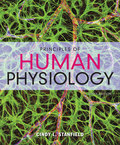
Concept explainers
Introduction :
There are few antigens and antibodies present on our red blood cells. They are used to tell the blood type and helps in the classification of blood. The presence of specific types of antigens and antibodies decides to or from whom an individual can donate or receive blood respectively. There are such blood types with which an individual can be a universal donor or recipient.
The ABO blood type has two antigens A and B. A person having same antigens can donate blood to one another. Rhesus (Rh) is also an antigen present on the red blood cells. In case a person is Rh positive, they have this antigen and if the person is Rh negative, the RBCs of the person lacks Rh antigen. In case, Rh positive blood is administered to the Rh-negative person, the Rh antigen would be treated as a foreign invader and elicit an immune response.
Want to see the full answer?
Check out a sample textbook solution
Chapter 23 Solutions
EBK PRINCIPLES OF HUMAN PHYSIOLOGY
- series of two-point crosses were carried out among six loci (a, b, c, d, e and f), producing the following recombination frequencies. According to the data below, the genes can be placed into how many different linkage groups? Loci a and b Percent Recombination 50 a and c 14 a and d 10 a and e 50 a and f 50 b and c 50 b and d 50 b and e 35 b and f 20 c and d 5 c and e 50 c and f 50 d and e 50 d and f 50 18 e and f Selected Answer: n6 Draw genetic maps for the linkage groups for the data in question #5. Please use the format given below to indicate the genetic distances. Z e.g. Linkage group 1=P____5 mu__Q____12 mu R 38 mu 5 Linkage group 2-X_____3 mu__Y_4 mu sanightarrow_forwardWhat settings would being able to isolate individual bacteria colonies from a mixed bacterial culture be useful?arrow_forwardCan I get a handwritten answer please. I'm having a hard time understanding this process. Thanksarrow_forward
- Biology How many grams of sucrose would you add to 100mL of water to make a 100 mL of 5% (w/v) sucrosesolution?arrow_forwardWhich marker does this DNA 5ʹ AATTGGCAATTGGCAATTGGCAATTGGCAATTGGCAATTGGCAATTGGC 3ʹ show?arrow_forwardThe Z value of LOD for two genes is 4, what does it mean for linkage and inheritance?arrow_forward
- Biology How will you make a 50-ul reaction mixture with 2uM primer DNA using 10 uM primer DNA stocksolution and water?arrow_forwardBiology You’re going to make 1% (w/v) agarose gel in 0.5XTBE buffer 100 ml. How much agarose are you goingto add to 100 ml of buffer? The volume of agaroseis negligible.arrow_forwardBiology How will you make a 50-ul reaction mixture with0.2 mM dNTP using 2-mM dNTP stock solution andwater?arrow_forward
 Human Anatomy & Physiology (11th Edition)BiologyISBN:9780134580999Author:Elaine N. Marieb, Katja N. HoehnPublisher:PEARSON
Human Anatomy & Physiology (11th Edition)BiologyISBN:9780134580999Author:Elaine N. Marieb, Katja N. HoehnPublisher:PEARSON Biology 2eBiologyISBN:9781947172517Author:Matthew Douglas, Jung Choi, Mary Ann ClarkPublisher:OpenStax
Biology 2eBiologyISBN:9781947172517Author:Matthew Douglas, Jung Choi, Mary Ann ClarkPublisher:OpenStax Anatomy & PhysiologyBiologyISBN:9781259398629Author:McKinley, Michael P., O'loughlin, Valerie Dean, Bidle, Theresa StouterPublisher:Mcgraw Hill Education,
Anatomy & PhysiologyBiologyISBN:9781259398629Author:McKinley, Michael P., O'loughlin, Valerie Dean, Bidle, Theresa StouterPublisher:Mcgraw Hill Education, Molecular Biology of the Cell (Sixth Edition)BiologyISBN:9780815344322Author:Bruce Alberts, Alexander D. Johnson, Julian Lewis, David Morgan, Martin Raff, Keith Roberts, Peter WalterPublisher:W. W. Norton & Company
Molecular Biology of the Cell (Sixth Edition)BiologyISBN:9780815344322Author:Bruce Alberts, Alexander D. Johnson, Julian Lewis, David Morgan, Martin Raff, Keith Roberts, Peter WalterPublisher:W. W. Norton & Company Laboratory Manual For Human Anatomy & PhysiologyBiologyISBN:9781260159363Author:Martin, Terry R., Prentice-craver, CynthiaPublisher:McGraw-Hill Publishing Co.
Laboratory Manual For Human Anatomy & PhysiologyBiologyISBN:9781260159363Author:Martin, Terry R., Prentice-craver, CynthiaPublisher:McGraw-Hill Publishing Co. Inquiry Into Life (16th Edition)BiologyISBN:9781260231700Author:Sylvia S. Mader, Michael WindelspechtPublisher:McGraw Hill Education
Inquiry Into Life (16th Edition)BiologyISBN:9781260231700Author:Sylvia S. Mader, Michael WindelspechtPublisher:McGraw Hill Education





